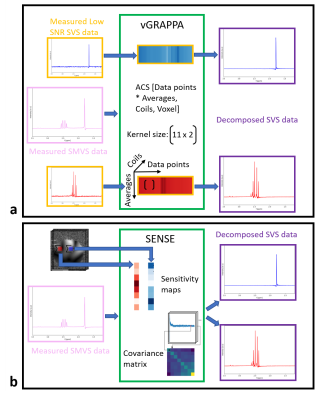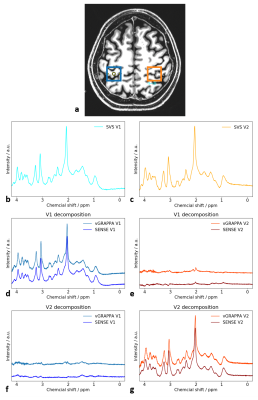Layla Tabea Riemann1, Christoph Stefan Aigner1, Ralf Mekle2, Sebastian Schmitter1,3, Bernd Ittermann1, and Ariane Fillmer1
1Physikalisch-Technische Bundesanstalt (PTB), Braunschweig und Berlin, Germany, 2Center for Stroke Research Berlin, Charité Universitätsmedizin, Berlin, Germany, 3Center for Magnetic Resonance Research, University of Minnesota, Minneapolis, MN, United States
1Physikalisch-Technische Bundesanstalt (PTB), Braunschweig und Berlin, Germany, 2Center for Stroke Research Berlin, Charité Universitätsmedizin, Berlin, Germany, 3Center for Magnetic Resonance Research, University of Minnesota, Minneapolis, MN, United States
This work demonstrates
the feasibility of a Fourier-based approach to decompose signals and assign the
locations after simultaneous dual-voxel acquisition for 1H MR spectroscopy
in vivo without the need for
additional image acquisitions.

Fig.3:
Diagram of both decompositions: a) vGRAPPA: Measured low SNR SVS data (yellow) is used to generate the kernel to decompose the acquired SMVS data (pink) to their respective voxel regions. The channel-wise ACS was obtained by 2D-stacking of the data points and averages. Then, this matrix was convolved with an 11x2 kernel to generate the pseudo inverse matrix following9. b) SENSE-based decomposition: channel-wise sensitivity maps and noise
covariance matrix, derived from image- and spectral data, respectively, are
used to decompose the SMVS data.

Fig.2:
in vivo acquisition: a) voxel region of the left
(blue, V1) and right motor cortex (orange, V2). b-c) Spectral shapes of the two
SVS acquisitions (cyan/orange) and d-g) the SVS acquisition decomposed like the
SMVS acquisitions with both the vGRAPPA (blue/red) and the SENSE-based (dark
blue/dark red) algorithm. Both algorithms should decompose the SVS voxel to its
respective region (d and g), while ideally resulting in equally distributed
noise for the other voxel (e and f).
